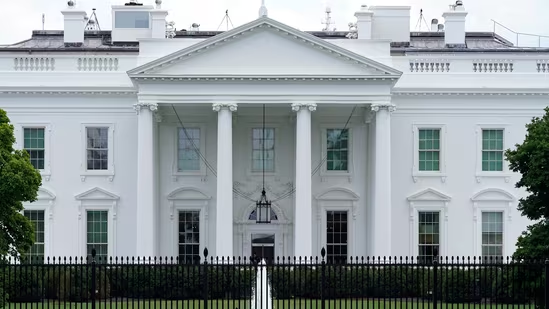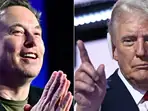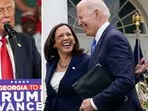Role of Electoral College and its power to swing US election explained
As the United States gears up to elect presidential election, it's important to understand the role of Electoral College system - the deciding factor in US elections. While most democracies around the world rely on a direct popular vote to elect their leaders, the U.S. has a distinctive approach that can sometimes defy the popular vote.

What is the Electoral College?
The Electoral College is a group of electors established by the US Constitution that formally elects the president and vice president. The system underscores the founding fathers’ desire to balance the influence of populous and less populous states. It also aims to safeguard against potential mob rule.
The Electoral College consists of 538 electors, with each state’s number of electors equivalent to its total number of members in Congress—both Senators (two per state) and Representatives (which vary based on population). Additionally, the District of Columbia, though not a state, is allotted three electors. To win the presidency, a candidate must secure a majority of the electoral votes, which means at least 270.
The Origin of the Electoral College
The Electoral College was established during the Constitutional Convention of 1787 as a compromise between those who wanted Congress to elect the president and those who favoured a direct popular vote. The framers of the Constitution were concerned about several issues: ensuring that smaller states had a voice, preventing regional candidates from dominating, and creating a buffer between the electorate and the presidency.
Originally, the process allowed electors considerable discretion in casting their votes, but over time, the role of electors became more of a formality. Today, electors are generally expected to vote in line with the popular vote of their respective states.
How the Electoral College Works
The process begins with the general election, held on the first Tuesday after the first Monday in November. While voters across the country cast their ballots for presidential candidates, they are technically voting for a slate of electors pledged to that candidate.
Also Read: How is the US President elected
US States and Electoral Votes Allotted
| State | Electoral Votes |
|---|---|
| Alabama | 9 |
| Alaska | 3 |
| Arizona | 11 |
| Arkansas | 6 |
| California | 54 |
| Colorado | 10 |
| Connecticut | 7 |
| Delaware | 3 |
| District of Columbia | 3 |
| Florida | 30 |
| Georgia | 16 |
| Hawaii | 4 |
| Idaho | 4 |
| Illinois | 19 |
| Indiana | 11 |
| Iowa | 6 |
| Kansas | 6 |
| Kentucky | 8 |
| Louisiana | 8 |
| Maine | 4 |
| Maryland | 10 |
| Massachusetts | 11 |
| Michigan | 15 |
| Minnesota | 10 |
| Mississippi | 6 |
| Missouri | 10 |
| Montana | 4 |
| Nebraska | 5 |
| Nevada | 6 |
| New Hampshire | 4 |
| New Jersey | 14 |
| New Mexico | 5 |
| New York | 28 |
| North Carolina | 16 |
| North Dakota | 3 |
| Ohio | 17 |
| Oklahoma | 7 |
| Oregon | 8 |
| Pennsylvania | 19 |
| Rhode Island | 4 |
| South Carolina | 9 |
| South Dakota | 3 |
| Tennessee | 11 |
| Texas | 40 |
| Utah | 6 |
| Vermont | 3 |
| Virginia | 13 |
| Washington | 12 |
| West Virginia | 4 |
| Wisconsin | 10 |
| Wyoming | 3 |
In most states, the Electoral College operates on a winner-takes-all basis. This means that the candidate who wins the popular vote in a state receives all of that state’s electoral votes. Only Maine and Nebraska use a proportional system, where electoral votes can be split between candidates based on congressional district results.
After Election Day, the electors meet in their respective states on the first Monday after the second Wednesday in December to cast their votes for president and vice president. These votes are then sent to Congress, where they are officially counted in early January.
Swing States and their power
The Electoral College has a profound impact on the outcome of U.S. presidential elections, and its design can sometimes lead to results that differ from the national popular vote. This power to swing an election lies in several factors:
The focus on swing states—those with electorates that are closely divided between the two major parties—highlights the Electoral College’s power. These states often decide the election because their electoral votes are not reliably Democrat or Republican. In recent elections, states like Florida, Pennsylvania, Michigan, and Wisconsin have played pivotal roles in determining the president.
Candidates invest heavily in campaigning in these swing states, knowing that winning them can secure the necessary electoral votes, even if they lose the national popular vote.
Popular Votes and Electoral Votes: The Disparity
One of the most contentious aspects of the Electoral College is the possibility that a candidate can win the presidency without winning the popular vote. This has happened five times in U.S. history, most recently in the 2016 election, when Donald Trump won the Electoral College despite losing the popular vote to Hillary Clinton by nearly three million votes.
This disparity occurs because of the winner-takes-all system in most states, where a candidate can win by a narrow margin in key states and secure all their electoral votes, even if they lose by large margins elsewhere. This system amplifies the significance of swing states and can lead to scenarios where the Electoral College outcome does not reflect the national popular will.
All about Faithless Electors
Although rare, the phenomenon of “faithless electors” adds another layer of uncertainty to the Electoral College. Faithless electors are those who, despite pledging to vote for a particular candidate, choose to vote for someone else. While the number of faithless electors has been small and has never altered the outcome of an election, their existence raises concerns about the reliability of the Electoral College.
Some states have laws penalizing faithless electors or nullifying their votes, but the US Supreme Court only recently ruled in 2020 that states have the authority to enforce such laws. Despite these measures, the potential for electors to vote contrary to their pledge remains a theoretical risk.
Criticism against electoral system and calls for reform
The Electoral College has faced significant criticism, particularly in the modern era, with some arguing that it is an outdated system that undermines the principle of one person, one vote. Critics contend that the system gives disproportionate power to smaller states and swing states, while the majority of voters in non-competitive states are essentially sidelined.
Some have called for a constitutional amendment to abolish the Electoral College in favour of a direct popular vote. However, this would require a significant political consensus, as amending the Constitution is a challenging process requiring approval by two-thirds of both houses of Congress and ratification by three-fourths of the states.
Despite its controversies and the calls for reform, the Electoral College remains a cornerstone of the U.S. presidential election system. Its power to swing elections—by focusing on swing states, potentially diverging from the popular vote, and allowing for the existence of faithless electors—ensures that it will continue to play a decisive role in American politics.
Disclaimer: The copyright of this article belongs to the original author. Reposting this article is solely for the purpose of information dissemination and does not constitute any investment advice. If there is any infringement, please contact us immediately. We will make corrections or deletions as necessary. Thank you.
Title:Role of Electoral College and its power to swing US election explained
Url:https://www.investsfocus.com







